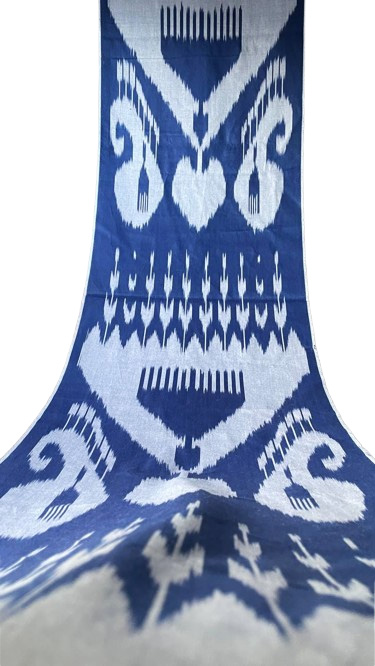Experience Regal Clarity: The Authentic Blue White Motif Ikat
Some designs are a statement, others are a legacy. This extraordinary textile from Uzbekistan is a masterpiece of both—a truly majestic Blue White Motif Ikat that evokes the grandeur of ancient palaces and the serene beauty of a cloud-strewn sky. This is not merely a pattern; it is a meticulously crafted visual poem, a testament to centuries of artistry, and a sophisticated choice for those who appreciate design that is both timeless and commanding.
The visual impact of this Blue White Motif Ikat is immediate and powerful. A deep, rich, almost royal blue provides a vibrant and authoritative background. Upon this profound blue, a stunning, intricate pattern unfolds in crisp, clean white. This high-contrast combination is classic, bold, and eternally stylish. The design is meticulously symmetrical, creating a powerful, totem-like structure that draws the eye upward, instilling a sense of order, elegance, and deep cultural resonance.
The Anatomy of a Woven Emblem
The genius of this fabric lies in its ability to combine traditional symbolism with a clarity that feels fresh and impactful.
The Royal Crests: The dominant shapes are large, stylized crests or medallions. These forms are reminiscent of royal insignia or ceremonial symbols, imbuing the fabric with a sense of nobility and importance. Their clean white outlines against the deep blue make them incredibly striking.
Feathered & Comb-like Details: Within and around these larger motifs, a wealth of intricate details emerges. Delicate, feather-like patterns and comb-like fringes add layers of texture and complexity, showcasing the artisan’s precision. These details give the design a refined, almost architectural quality.
The Soulful Mark of Ikat: What truly elevates this Blue White Motif Ikat from a simple print to a work of art is the signature abr (cloud) effect. The soft, feathered edges where the blue meets the white are the authenticating mark of the hand-dyeing process. This beautiful imperfection breathes an organic soul into the precise geometry, ensuring the design feels alive and uniquely handmade, far beyond any machine-made imitation.
The Ideal Foundation for Enduring Style
A design of such regal clarity and intricacy requires a material that can honor its vision. This Blue White Motif Ikat is typically crafted from a premier Adras blend of a silk warp and a cotton weft. This combination is perfected to deliver both visual beauty and practical performance. The silk warp is essential for achieving the deepest blue and the cleanest white, providing a subtle, elegant luster that makes the colors glow. The cotton weft provides the necessary body and structure, ensuring the intricate pattern remains crisp and the textile is durable.
A Canvas for Grand and Sophisticated Design
The powerful, artistic, and versatile nature of this fabric makes it a superb choice for creating refined, majestic, and unforgettable spaces and garments.
For Interiors of Grandeur: This Blue White Motif Ikat is a designer’s tool for creating spaces that feel both refined and commanding. Use it to upholster a signature piece of furniture, such as a tall-backed armchair or a formal settee, instantly elevating the room. As a large wall tapestry or a set of opulent curtains, it becomes a magnificent piece of architectural art, drawing the eye and adding a profound sense of cultural depth.
For High-Fashion Statements: This fabric is ideal for creating garments that are both elegant and commanding. Imagine a striking, structured coat, a tailored blazer, a dramatic full skirt, or a minimalist sheath dress where the fabric is the star. A piece made from this Blue White Motif Ikat is an investment in wearable art, a statement of confident, impeccable style.
By choosing this authentic textile, you are not just acquiring a pattern. You are investing in a piece of woven legacy, celebrating a craft that turns thread into a symbol of enduring beauty, and acquiring a Blue White Motif Ikat that will inspire awe for generations.











2 reviews for Blue White Motif Ikat